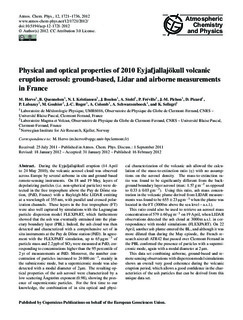| dc.contributor.author | Hervo, M. | |
| dc.contributor.author | Quennehen, B. | |
| dc.contributor.author | Kristiansen, Nina Iren | |
| dc.contributor.author | Boulon, J. | |
| dc.contributor.author | Stohl, Andreas | |
| dc.contributor.author | Freville, P. | |
| dc.contributor.author | Pichon, J.M. | |
| dc.contributor.author | Picard, D. | |
| dc.contributor.author | Labazuy, P. | |
| dc.contributor.author | Gouhier, M. | |
| dc.contributor.author | Roger, J.C. | |
| dc.contributor.author | Colomb, A. | |
| dc.contributor.author | Schwarzenboeck, A. | |
| dc.contributor.author | Sellegri, K. | |
| dc.date.accessioned | 2018-04-26T11:05:48Z | |
| dc.date.available | 2018-04-26T11:05:48Z | |
| dc.date.created | 2012-06-15T13:21:16Z | |
| dc.date.issued | 2012 | |
| dc.identifier.citation | Hervo, M., Quennehen, B., Kristiansen, N. I., Boulon, J., Stohl, A., Fréville, P., Pichon, J.-M., Picard, D., Labazuy, P., Gouhier, M., Roger, J.-C., Colomb, A., Schwarzenboeck, A., Sellegri, K. (2012). Physical and optical properties of 2010 Eyjafjallajökull volcanic eruption aerosol: ground-based, Lidar and airborne measurements in France. Atmospheric Chemistry and Physics, 12, 1721-1736. doi:10.5194/acp-12-1721-2012 | nb_NO |
| dc.identifier.issn | 1680-7316 | |
| dc.identifier.uri | http://hdl.handle.net/11250/2496111 | |
| dc.description.abstract | During the Eyjafjallajökull eruption (14 April to 24 May 2010), the volcanic aerosol cloud was observed across Europe by several airborne in situ and ground-based remote-sensing instruments. On 18 and 19 May, layers of depolarizing particles (i.e. non-spherical particles) were detected in the free troposphere above the Puy de Dôme station, (PdD, France) with a Rayleigh-Mie LIDAR emitting at a wavelength of 355 nm, with parallel and crossed polarization channels. These layers in the free troposphere (FT) were also well captured by simulations with the Lagrangian particle dispersion model FLEXPART, which furthermore showed that the ash was eventually entrained into the planetary boundary layer (PBL). Indeed, the ash cloud was then detected and characterized with a comprehensive set of in situ instruments at the Puy de Dôme station (PdD). In agreement with the FLEXPART simulation, up to 65 μg m−3 of particle mass and 2.2 ppb of SO2 were measured at PdD, corresponding to concentrations higher than the 95 percentile of 2 yr of measurements at PdD. Moreover, the number concentration of particles increased to 24 000 cm−3, mainly in the submicronic mode, but a supermicronic mode was also detected with a modal diameter of 2 μm. The resulting optical properties of the ash aerosol were characterized by a low scattering Ångström exponent (0.98), showing the presence of supermicronic particles. For the first time to our knowledge, the combination of in situ optical and physical characterization of the volcanic ash allowed the calculation of the mass-to-extinction ratio (η) with no assumptions on the aerosol density. The mass-to-extinction ratio was found to be significantly different from the background boundary layer aerosol (max: 1.57 g m−2 as opposed to 0.33 ± 0.03 g m−2). Using this ratio, ash mass concentration in the volcanic plume derived from LIDAR measurements was found to be 655 ± 23 μg m−3 when the plume was located in the FT (3000 m above the sea level – a.s.l.). This ratio could also be used to retrieve an aerosol mass concentration of 579 ± 60 μg m−3 on 19 April, when LIDAR observations detected the ash cloud at 3000 m a.s.l. in correspondence with model simulations (FLEXPART). On 22 April, another ash plume entered the BL, and although it was more diluted than during the May episode, the French research aircraft ATR42 that passed over Clermont-Ferrand in the PBL confirmed the presence of particles with a supermicronic mode, again with a modal diameter at 2 μm. This data set combining airborne, ground-based and remote sensing observations with dispersion model simulations shows an overall very good coherence during the volcanic eruption period, which allows a good confidence in the characteristics of the ash particles that can be derived from this unique data set. | nb_NO |
| dc.language.iso | eng | nb_NO |
| dc.rights | Navngivelse 4.0 Internasjonal | * |
| dc.rights.uri | http://creativecommons.org/licenses/by/4.0/deed.no | * |
| dc.title | Physical and optical properties of 2010 Eyjafjallajokull volcanic eruption aerosol: ground-based, Lidar and airborne measurements in France | nb_NO |
| dc.type | Journal article | nb_NO |
| dc.type | Peer reviewed | nb_NO |
| dc.description.version | publishedVersion | nb_NO |
| dc.rights.holder | © Author(s) 2012. | nb_NO |
| dc.source.pagenumber | 1721-1736 | nb_NO |
| dc.source.volume | 12 | nb_NO |
| dc.source.journal | Atmospheric Chemistry and Physics | nb_NO |
| dc.source.issue | 4 | nb_NO |
| dc.identifier.doi | 10.5194/acp-12-1721-2012 | |
| dc.identifier.cristin | 929804 | |
| cristin.unitcode | 7460,57,0,0 | |
| cristin.unitname | Atmosfære og klima | |
| cristin.ispublished | true | |
| cristin.fulltext | original | |
| cristin.qualitycode | 2 | |

